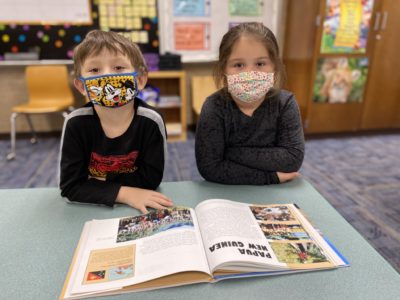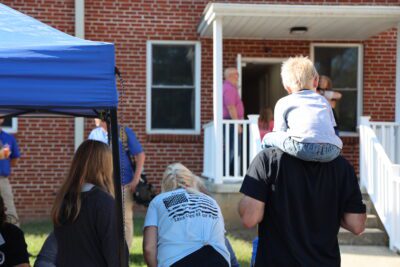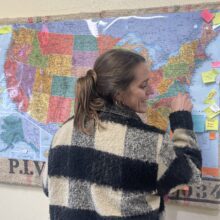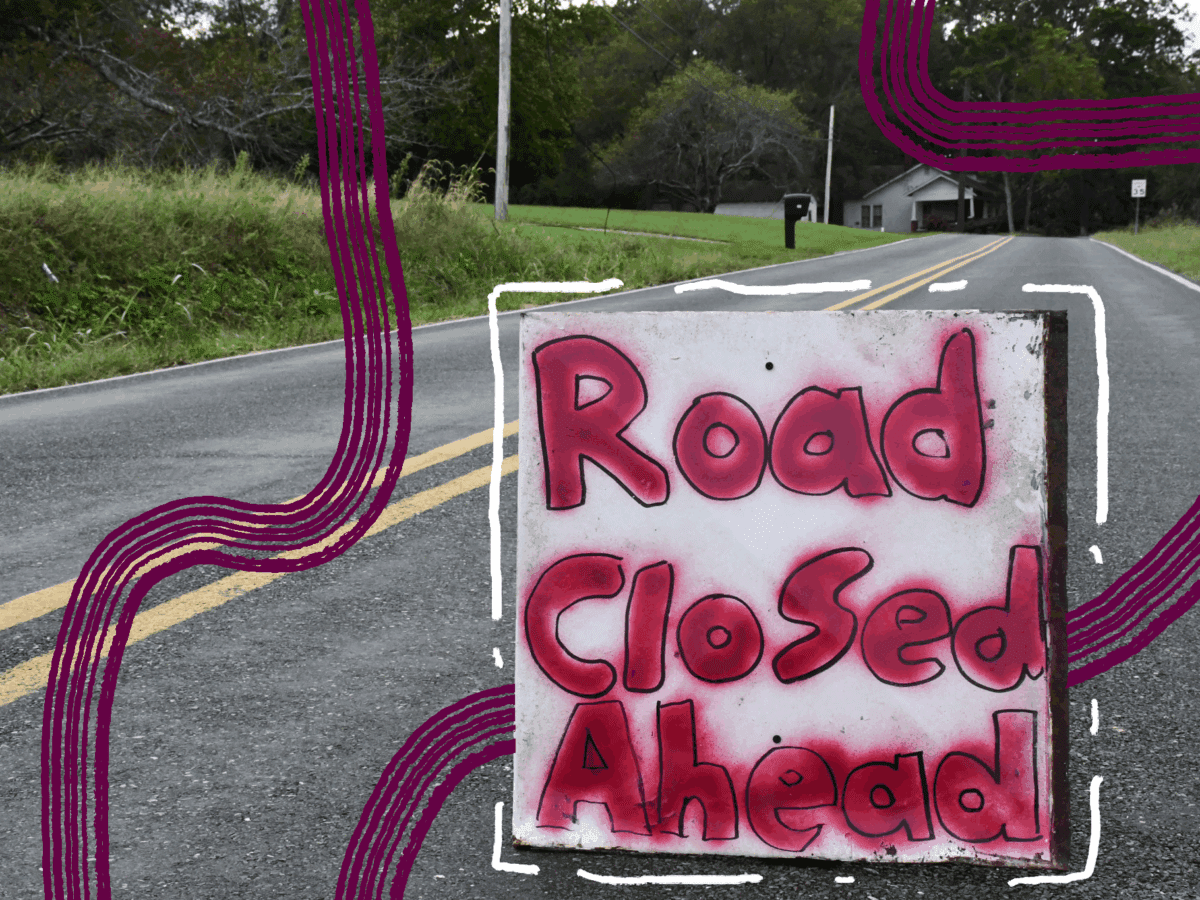
|
|
Click here for full audio transcription
Caroline Parker: My name is Caroline Parker, and I am an education reporter. One year ago, Hurricane Helene made its way into the Appalachian Mountain Range, devastating western North Carolina. Here is former Governor Roy Cooper on September 26th, 2024.
Gov. Roy Cooper: This is an unusually dangerous storm that threatens to bring heavy rain and potentially catastrophic flooding tonight and tomorrow for central and particularly western North Carolina.
Caroline Parker: Before Helene, the region had what they call a predecessor rain event. The area was already soaked in water from heavy rainfall – soil was saturated and river levels were rising. Then came the hurricane. Less than a week after the storm, 25 of North Carolina’s 100 counties were declared federal disaster areas. That’s a fourth of the state.
And what does that much water do when it’s dropped in a place where it’s not supposed to be? According to two students from Haywood Community College, Tony Gündüz and Michael Archer, it moves everything out of its way –
Tony Gündüz: We had one lady we were helping out in Barnardsville.
Michael Archer: We were at this horse ranch. We were cutting up some walnut trees, because if they’re in the water, they can contaminate it.
Tony Gündüz: You know, her house was fine, but most of her outbuildings were pretty damaged. And she had one large barn that was untouched, seemingly.
Michael Archer: This lady was showing us around her property
Tony Gündüz: I’m like, you know, this is good news.
Michael Archer: And she pointed to this big white barn. And she was like, you see that barn? And we were like, yeah.
Tony Gündüz: She’s like, that’s not my barn.
Michael Archer: This massive barn had lifted up and washed down stream and then just sat perfectly in her yard. Nothing had moved, nothing had gotten, like, tipped out of it. It just, like, lifted up and it looked like it was supposed to be there.
Caroline Parker: This was just one of a thousand scenes in western North Carolina during that period. And yet, in a time of great distress the region answered with action.
Neighbors were cutting trees for each other, liberating driveways and roads. Friends hiked through freshly broken forests to set eyes on their loved ones. People shared finite resources like they were unlimited.
Leading rescue efforts were the state’s first responders and essential workers – those who are trained to answer your calls for help.
And where does this happen? Where are these essential workers, the folks who respond to disasters, where do they learn these skills? At your local community college.
In October 2024, Dr. John Gossett, president of Asheville-Buncombe Technical Community College said this, “Think about who went running. It was our law enforcement, EMTs, fire, rescue, all these people we have trained — they were the ones who ran immediately into the storm.”
Gossett was right, and EdNC decided to go looking for those community college students and alumni, who in the face of crisis – headed towards it to help.
This show is called “Running Towards Disaster,” and was inspired by Gossett’s words and the actions of our North Carolina students.
You are about to hear a collection of stories from those who lived through and helped in the aftermath of Helene – from firefighters and EMTS to lineworkers and forestry students. And many of these folks – the ones who were on the frontlines in the aftermath of Helene – were educated at a community college. Some chose a profession of public service, some learned skills that they never knew they’d need, but they were all there and aided in the recovery of their communities.
The awe-someness of this storm was and continues to be matched, in equal and greater measure, by the humanity that shows up. But I don’t need to tell you that — they can.
First up is Dr. John Gossett of Asheville-Buncombe Technical Community College, or AB Tech for short.
Dr. John Gossett: Wednesday, I was up in Avery County, and our law enforcement folk called and said, ‘The garage is starting to flood.’ And I said, ‘The parking garage? There’s nothing there.’ ‘Well, it’s starting to flood. What do we do?’
Started talking to my leadership team and just thinking about the eye of the storm had still not reached Florida, at that point. The eye of the storm is not supposed to be here till Friday, you know? Well, let’s be prepared. They encouraged me then to cancel classes on Thursday so we could prepare our campus, and our people could prepare themselves. So we stayed home Thursday.
Friday morning, I got a phone call from the county manager. ‘We need your building.’ Yes. The answer was an immediate and emphatic yes. About 30 minutes later, she called, ‘we need your other building.’ An immediate emphatic yes. We’ll figure out the details later. But she got the buildings unlocked, and then communication evaporated.
I called our vice president, and she just said, ‘Do you know how bad Asheville is?’ I said, ‘As a matter of fact, I don’t because I can’t, there’s only one way to get into campus.’ I can see the river is up, but we really don’t have communication. And she said, ‘The national news, it’s bad. It’s really, really bad.’ So we’re having to hear from other people how badly we were devastated.
Our leadership team got together formally Sunday. At that first meeting, let’s put an org chart on the wall, and let’s find our people. So we were looking on Facebook. We’re looking on Twitter, like, okay, do that with yellow so we know that they’ve made a statement, but let’s phone call them. Let’s talk to them person to person, and then we’ll highlight that in pink so we’ll know who we have contacted. We heard an awful lot of people telling us how much they appreciated that. Most of them, ‘No, we’re good.’
First thing, we said, ‘Let’s find our people.’ Second thing, how are we going to make payroll next month? That was a short conversation. We’re paying people. And then, of course, well, we don’t have time sheets. We’re paying people. We’ll figure it out later. We’re paying them. We called in our payroll guy to talk through the process with him.
Okay, everything good. He leaves. And someone says, ‘Well, you did know he lost his house?’ No, I didn’t know that! Why didn’t somebody tell me? So run down the hall, ‘Dude. I’m so sorry. Are you okay?’ ‘Oh yeah, my dad and I found another place. We’re good. I’ll get right on it.’ But he was willing to worry about everybody else, you know. And those are the stories that really keep me going.
Every campus that we have some presence on was used. Madison County campus, when Marshall was washed away, they moved all of their town offices to our campus. It was also used as relief distribution site, helicopter pad, you name it. It’s kind of in the center of the county anyway. Everything was used at Madison.
Our Woodfin campus, for lack of a better phrase, was a FEMA town. FEMA brought in a lot of trailers for housing, food, washing machines for their workers, so they took over our entire driving track at Woodfin.
Here on campus, 300 ambulances were in our parking lot, just in preparation if the hospital needed to evacuate. Thank God it didn’t have to evacuate, but we still had all of those ambulances and their personnel there.
Two of our buildings were used as shelters. One was a medical shelter because we had a generator, so we could get power to oxygen machines for the medical folk. Then our conference center was used as a general shelter. A third building was used then to house all the workers, Red Cross people, that supported those shelters.
So Inca was probably the least used. The county also asked for a space for debris removal, for short term, kind of pile it up and then take it off. They used it very, very little for that, but we were still able and ready for those big projects.
And it’s been a slow build for me personally. You know, in the heat of it, that first month. We’re coming into the office every day trying to figure out, what can we do to support those shelters as a leadership team, what can we do to support our people?
A lot of people came to help. We saw there was law enforcement officers – and I’m like, where are you from? Louisiana. Where are you from? Wyoming. Holy cow. Yeah, we had a three day, three days open. Y’all help us. We help y’all. That’s how, that’s how it works.
Our fire academy sends their students to their fire stations on Friday. That’s just part of their work-based learning. Well, that’s when the storm hit. So all of our students were at their fire stations. And in a disaster like that, you know those fire chiefs were like, we can’t worry about whether you’ve got the right certification or not. I need your help right now, get in the truck. Let’s go. So we knew that there was a good number of our fire students were doing that kind of work.
We lost about 25% of our students in the fall. Rightly so. They had bigger fish to fry. 70% of our students are part time. So they’ve got jobs, they’ve got families. We are third, fifth, sixth on the list of their priorities, and I understand that. So when those students walked away from fall semester, I told my chief academic officer, if a student is going to earn an F this semester, the faculty needs to come to my office and explain to me why. Right?
Remarkably gracious with our students in the fall. Our faculty, without having to be told, found their students just like we did a phone tree for them. They started reaching out to their students where they could. And most of our programs, especially our technical programs, are cohorted. They know their students well. They’re very well connected.
I think because of that, the students came back in the spring, they saw how much we cared about them as people. The scholarships are great, and we appreciate all the help that the General Assembly has given to us, that our system office is giving to us. I don’t want to discount that at all. That’s a big part of how they were able to get back here, right? But, I have to believe the way our faculty treated their students as people, as humans first, as students second, I think that made a difference.
John Wilson: My name is John Wilson, and I’m the director of fire services at Asheville Buncombe Technical Community College, and we’re located at the Woodfin, North Carolina campus.
Our fire academy students, we are in class and out on the training grounds, doing our hands on skills, usually Monday through Thursday, and then Friday, they do an internship at their sponsoring fire departments.
On that Friday when the hurricane hit, a lot of them went to their stations. And between the EMT group and the fire group, they put in almost 5,000 hours worth of community support.
We weren’t sure exactly what all the fire departments would allow the cadets to do during the hurricane. We knew the hurricane was coming. We had no clue that it was going to be to the extreme that it was.
We had a lot of flooding prior, and then come Friday, I was off, and so once the call started coming into the fire department, then I went to the fire department and actually stayed on duty for the first 24 hours.
Then after I went home, I stayed home and rested for a little while and came back in. And then we actually got put on 12-hour shifts. And so during the day for the next week, we were helping with communications and taking phone calls about donations, and we were working getting all that set up.
One of the things that you look at the river, you always hear about water always follows a path of least resistance. However, in this situation, it was following the path of least resistance, but it was also making its own pathway as well.
I actually had two of our students that were at that station, and since then actually both of those have been hired full time by that department.
We are finding that we have a lot of people that are wanting to get into the Fire Academy, and I think a lot of that may have to do with Helene because a lot of people were out there volunteering. The community came together so well, but they didn’t have the training that they needed. And I think that this is playing a lot into the academy. Two of our academy students this last time, they actually came here for hurricane relief and stayed and joined our academy.
Caroline Parker: You just heard from Dr. John Gossett, president of AB Tech, and John Wilson, the school’s resident fire chief. Their community college service area covers the city of Asheville and all of Buncombe County. AB Tech’s main campus sits within two miles of the French Broad River.
The French Broad meets the Swannanoa River at Biltmore Estate. And during Helene, it was recorded that the Swannanoa River broke its previously held cresting record, swelling to a height of 27 ft. Here is Krystal Shuler, a paramedic and the emergency medical services program coordinator at Haywood Community College, which is – located about 24 miles west of AB Tech’s main campus.
Krystal Shuler: I don’t expect when I’m driving uphill to run into ponds of water so, yeah, that one was different. As you’re driving and you see entire single wide trailers or vehicles floating by until they hit a structure, and they either take said structure out, bridges and stuff, or they just crumble into a million pieces and get sucked on down and they just keep going.
Caroline Parker: Krystal works in Emergency Medical Services, and trains students at Haywood Community College to do the same. You are about to hear from her, Cade Parkins, and John Carrico. They all work in emergency medicine in some way.
When you call 911 for help, they are on the other end of the line and they are the first ones on the scene for your emergency – by ambulance or air.
Krystal Shuler is up first.
Krystal Shuler: So my Sept. 28 started off as a shift where we knew that there was a good chance that we were going to flood. So I was the supervisor for Haywood County EMS, I have a large portion of the paramedics that work on my shift came out of our program. So we started our day off knowing that it was going to get hectic and communications was obviously going to be a problem because we’ve had flooding in our area before.
But when this flood hit and came in, like, it took down all of our communications.
We lose radio frequently with floods, but we lost cell phone service, the whole nine yards this time, which has never been a thing in the past. So we went to the old ‘Hey, everybody’s going to meet here. We’re going to have to run out of here. And then you will get your assignment in person, and you’ll go to that call and you’ll come back until we could get where the radios were up enough for us to be able to communicate backwards and forth.’
So I had trucks in areas like Cruso that were cut off and could not get to me. We had like, our EOC center, it was surrounded by water at one point. Couldn’t get in or out of there. We couldn’t get in and out of where our actual major supply area is at our main base. We had to wait for the water to recede to be able to go restock. So we basically staged in different parts of the community and ran on fire departments.
So we were checking on approximately 100 to 150 a day that we could clear off of the missing persons list. And we did a total of, if I’m not mistaken, right around 1,500 in two weeks, of locations.
We prepare for disasters. We literally have a day where we run nothing but scenarios for 18 hours straight with a paramedic class towards the end, where it’s a day in the life of. And every horrible call, or challenging call, that I have had in 21 years, they get in 18 hours. So if they can live through that, then they’re prepared to go out into the real world. But you get in the mindset when you’re a paramedic of being prepared for a disaster every day you go to work.
If there’s a disaster down east, then we deploy east. If there’s a disaster, in the western end of the state, the east comes to us. We take care of the state of North Carolina. There will be another disaster, some version of a disaster will happen, and having plenty of trained, educated, ready to go responders will make all the difference because you can bring in outside sources all day long to relieve those responders, but that first 24 is on us.
You won’t get outside sources. You don’t know a disaster is going to happen, so you have to plan like the first 24 is for you to deal with.
Caroline Parker: Shuler taught, Cade Parkins, who you’ll hear from next. Cade attended Haywood Community College, and is an instructor there now. He still actively serves his region as a paramedic, firefighter, and dispatcher.
Cade Parkins: So, the day the flood happened, I just worked off at Maggie Fire Department and actually spent the day of the flood working in the 911 center. Taking calls, sending resources. I actually worked one of the fire channels for Waynesville Fire Department. We would take the emergency calls, we would triage them or prioritize them, and then we would send the units out to assist them.
Whenever I went into the morning, it was kind of the beginning of the flood, and then probably about an hour or two after I got there, we completely lost internet. The county cell system pretty much went down. But at that point, we were getting 911 calls off the hook, essentially.
We’d done a bunch of welfare checks. People would call in. We’d have to go check on people, make sure they got out, go assess landslides. We’ve done a few rope rescues, because some roads were inaccessible to people, so we’d have to find other means to get them out.
I think there wasn’t necessarily a story that surprised me, but I think it was the amount of incidents that happened all at once. I mean, you’ll get a swift water rescue incident every now and again. But to have 20 or 30 happen at one time is a little unheard of for the county, especially. But, I mean, you’ll get landslides, but we were getting landslides into houses. We were getting landslides across roadways. So I think the big thing that happened out of this was the actual quantity of incidents that were all happening at once.
For my time that I’ve been here, this is probably the first time that I’ve actually seen a whole county-wide flood happen in Haywood County.
Going back to answering calls at the 911 center, I mean, you would take calls of the interstate starting to crumble and and just to look at the destruction that happened down at the interstate. I mean luckily, IMAP and highway patrol was able to get those people to safety, but I never thought that I would see an entire interstate get washed away in Haywood County, especially after something like this.
I think it, if you really look at it, it kind of humbles you to know the power of Mother Nature and and not only that, but it also shows you the power of a community coming together. I mean, if you think back to Hurricane Fred or Tropical Storm Fred, we all come together for that. All helped each other out. And like I said, Fred was more of centralized towards the east end, but Helene was very much so a county-wide response. And it really showed me that in times of crisis, that we can all come together, put any differences we have aside and really come to support our community.
Caroline Parker: John Carrico is a flight paramedic, and flies on the Mountain Area Medical Airlift – also known as MAMA. MAMA performs critical care in the air and delivers patients to regional hospitals.
Asheville’s Mission Hospital has three helicopters to use in times of emergency and those three helicopters serve 19 counties in western North Carolina. They were all deployed in the wake of Helene. Here is Carrico.
John Carrico: For me, I was scheduled that Wednesday and Thursday and obviously it was just absolutely raining so much, and so my wife, who also works up here, we live about 45 minutes away, so we didn’t know if we would make it home. We were able to on that Thursday night, despite all the rain. And then from there, you know, the storm obviously hit that Thursday night and then it was radio silence.
So 45 minutes away, and the communication network was completely down. We sat for about 36 hours of having no idea other than our neighborhood in our town. We had no idea the extent of damage that was out there.
I made it here that Sunday morning after the storm. So, we had gotten word that there was a pocket of cell phone service about 25 minutes away from where we lived. The bridges were not underwater anymore, so we could get there. And of course, as soon as my cell phone hit signal, 200 messages from friends, family, all across the country.
First phone call was to my parents to let them know that we’re alive and safe. And then the second one was to my manager here. Her voice was teary eyed, like, oh my God, thank God, another one of her people is okay. Because again, I didn’t know how bad it was. And then she just said, ‘It’s really bad. When can you get here?’
Immediately it was, the difficulty was communications. Normally, it’s a very seamless process of when you need to have a helicopter come through the various dispatch centers. But because, you know, the communications were just down everywhere, that was a little bit more in flux, but we knew that, you know, there was people calling and we had patients to pick up.
And so we were doing that. But least we had a state radio system that we could use. We have three helicopters – two helicopters are always in service, and we have a spare helicopter when we have to do maintenance on the other. We knew immediately we needed that third helicopter. We got that prepared, and then we started using that, essentially at first, as a logistical helicopter.
So, there was doctors that had been on for six, seven days straight, and they couldn’t get home. There was even some of our dispatchers. So we literally started shuttling people.
We took Starlink to our hospitals because the telephones were all down. And so we took Starlink so we could establish communications. We were the easiest way to get from point A to point B because so many of the roads were not passable.
The other thing that we had to do was we had to take patients away from this hospital that were high-risk patients. You know, water obviously was the big issue. You know, we had to deal with water issues here. And so the hospital made a really good decision of patients who are really high water needs, like for example, like dialysis patients, they need a constant water flux. We took a lot of those patients who were high needs, and we flew them to other hospitals so that we could continue to accept patients here, but those patients could be, you know, seen in other hospitals and not have the worry of, you know, water issues.
We had running water here, thanks to Herculean efforts to make that happen. But when it was appropriate, we flew a lot of those patients out too. So, we were crisscrossing the state, and thankfully, many hospitals were amazing. The whole state came together to allow us to really move patients.
Once we got in the air, I think it was this, like we started to see the vastness of the destruction. Even to this day, it’s hard to describe because we will fly along, things will look normal, and then you’ll cross a ridge line, and then acres and acres of acres of trees are all down. Just they look like match sticks. In that original couple days of flying, we were the first ones to see that.
When you’re in our line of work, we have to have difficult conversations with families. When we pick up a patient who’s very critically, critically ill and fly them to Mission Hospital or wherever we’re going, we try not to instill a false sense of security. Just because we’re putting them in the helicopter and flying them away doesn’t mean everything’s going to be all right. Anytime we take someone’s loved one, we try to communicate that like we’re going to take excellent care of your loved one, but they’re in really bad shape right now. And I want you to know that before we go flying them off. So those are difficult conversations that our team does on a routine basis.
It’s part of what we do. But during the initial days after the flood, there were times when we were picking up people and their family members were there living in the hospital because they had no place to go. They had lost everything. And then, now, we have to take their loved one and fly them away. And they have no way of getting here. They have no way of communicating because, you know, we don’t have service.
They have no way of following up to know that their loved one got on a helicopter and made it safely. You know, normally, when I fly someone, once we get them settled in a room, I call their loved one to let them know because that’s a traumatic, you just saw your loved one fly off in a helicopter. And so we want to make sure that they know they got here, this is where they’re at. But we couldn’t do that in those days.
Again there were many people who stayed at this hospital who did not know how their families were because they were here during the storm, and then communications were down, and yet, the resolve to stay with the mission of, ‘I’m here to do my job and take care of people.’ There’s a lot of pride with that, you know, that comes with that. I mean, how everyone rallied to take care of each other.
So many of the people who responded and continue to respond are a product of the community college system. I mean, our nurses, so many of our nurses got their start from the community college system. As you’ve already interviewed, our firefighters, our paramedics, our linemen. It really is a testimony to the power of that, that community college system.
I have a bachelor’s degree, a master’s degree, but I’m probably most proud of my Associate’s degree. It’s the one I use so much on a day to day and kind of got me to where I am today.
Caroline Parker: A storm like Helene brings powerful wind and rain that almost always knock out electricity. And when the power is down, these next folks are called up.
Before Helene hit, electrical lineworkers were already out in the field due to that predecessor rain event I mentioned earlier, trying to restore electricity to those who already lost it before the storm’s arrival. And in the weeks following the storm, If you were in western North Carolina, you couldn’t miss the bucket trucks camped out in the parking lot of every Ingles grocery store – waiting to take off and provide help around the clock.
According to the Hurricane Helene Damage and Needs Assessment from December 2024, there were 900,000 homes and businesses without electricity due to the storm at one point. And that’s only the reported number of buildings without power – it doesn’t even begin to relay the number of people who spent weeks/days/months living in the dark.
Tyler Rogers and Cory Bolick are two alumni of the Electrical Lineworker Institute at Caldwell Community College. While working full time for their respective companies, they’ve both returned to Caldwell to instruct at some point, paying back the brotherhood that helped begin their careers. During recovery, one was in a bucket truck, the other in a helicopter. They looked at lines and worked to turn the lights back on in western North Carolina. Here they are.
Tyler Rogers: My name is Tyler Rogers.
I work for Duke Energy on the transmission side. Our normal day, my crew in general, we’re considered a maintenance crew. So we go around and do inspections, so we maintain it and update it, and we work it energized, so that way we’re able to keep everybody’s power on as we’re fixing it.
We get prepared normally about a week in advance, but we don’t really know the significance of what’s going to happen. But Helene was a little different, because we was getting the rain and the storms before, so we was working weeks ahead of time, fixing damage that occurred already. We was working the night Helene hit, and we just had to go take shelter at the office and wait till the storm pass, and then we assess the damage. And we started driving, and we realized you can’t get vehicles anywhere. So we regrouped and got into our what we call it a storm room.
It’s a big room. We can pull up our grid and see everything that’s out and, you know, get everything live feed. So we called in helicopters and started patrolling with helicopters and four wheelers and figured we’d assess the damage, and then we’d come up with a game plan to go tackle it and get it done.
I was unique to this storm. So I have my ‘Fly on the Wire’ certificate, so I got designated to fly in the helicopter. I’m sitting in a helicopter with no doors on it, and I’m sitting on the side of the helicopter, leaning out, looking, we’re flying at a low level, and we’ll be probably 100 foot above the power line, so I’m flying within range to see with the naked eye and also, you know, being able to assess the damage thoroughly through the helicopter. If it’s a field, a wide open field, and I can’t see it good we’ll land, and I’ll maybe walk through the woods, but 90% of time I’m flying and following my tablet and my GPS and I’ll drop coordinates and write the damage down for people to go back and put physical eyes and hands on.
So I was getting to see the damage from an air. So, they give me priority lines, is what we call them, because you can’t pick up smaller lines before you get these lines on so you have to work from priority to less priority. So I’ll fly the wire for the priority lines, and then I’ll figure out what damage needs to be done on those. And then I’ll go back, land at the office, give them my assessment and they’ll send crews out to go out there and physically fix the work. And then I’ll move on to the next priority and I’ll just keep working my way down until the end of the storm, until we get everything back on.
We flew for three weeks straight, and then probably 12 hours a day, and then I took the other four hours to probably come back and go through my paperwork and notes to divvy it out to crews to go fix the next day. So I was trying to stay a day ahead of them, far as damage, or if it was something, you know, really dangerous, I would call it in. We’d land, I’d call and they’d go out right away. But I tried to plan the next day for the crews on the ground.
I work with a lot of older guys and just so people maybe can understand that Helene for me, that’s the worst storm I’ve ever seen, far as in our area, and just worst storm in general, just devastation. And then they compare it to Hurricane Hugo, what hit North Carolina, and everybody I’ve worked with said this is, by far, on a power perspective, the damage to the power lines is way worse than Hugo.
When I come through, nobody knew what a lineman class was. I think I was the fourth class to come through here. I’ve decided to come back and help instruct it on my days off. So so that’s why I really support the school, because it’s helped me and changed my life. So I want to help other students.
Cory Bolick: My name is Cory Bolick.
I’m an electrical lineman. I’m an A class lineman, so yeah, I’m the guy that’s helping you get the lights back on. I work at Blue Ridge Energy out of Lenoir.
For me as a young man, I did relate sports to a career at that time. Similarities that it shares, regardless of what sport or team leadership that you may involve with, being a electrical lineworker, you can’t do it on your own. And it does take a team and whether it’s linemen or people in administrative or just all different levels. It takes everyone.
You don’t prepare for a hurricane the day before, that should be part of your routine of what we do. So I think with the way we operate, kind of minimize the scary factor. And I think you know, when you go home and you watch the news and you’re seeing these rain charts of 12, 13, 14 inches, you kind of start preparing your mind.
We knew it was going to be bad, we just didn’t know how bad. So when you’re able to prepare your mind and prepare for the worst, it minimizes the ‘oh, what do we do?’ you know, because we are the ones that are called in for help. There’s no one else that can do it, as far as when it comes to getting the lights back on.
Once the storm arrived, we were already on standby, and they called us in, and it kind of slowly started making its landfall, so to speak, or in our county. And you know, we’re having some outages as it starting to enter, and so we’re working already. We’re already in the field trying to keep lights on, and we’re just maintaining it at this point, and then later on that day, it’s just like somebody turned the fans on. It just came in and never let up. And there for a while we were fighting it the best that we could, but eventually you got to know when to pull out.
And so we had to back up and punt a little bit. But once it was safe for us to get back out there, we immediately started back working. So yeah, I’ll never forget the while working, the trees are falling as you’re on a pole. You know, it’s literally falling on wire that you just put up, and they’re falling behind you and then there’s water, six, eight inches up on your tires and wheels. And, you know, there’s a lot of things to think about, and at the end of the day we’re responsible for our own safety. So yeah, that’s when it really set in. This is something I’ve never seen.
So we worked around here and we got our area back on and then we started going out to other counties to help where it was far more worse.
Even for our county, Caldwell, all the way up to Sparta, we were very thankful to have, we call them brothers and sisters, relationships, but other co-ops that came in. You know, we would have never been able to have the response that we had without those people. So we were very thankful for other co-ops and municipalities that were willing to take time and come help us. And likewise, when we went to Burnsville, which is where I call the bomb went off. That was who we were for them. So you know, priority was get our co-op back on, get our members taken care of, and then once we’ve achieved that, we’ll move out and help others.
And you know, we talk about how bad it is, but also the good outweighs the bad. The bad was a hurricane. It was destructive and lives were lost, houses were lost. But I think what is so satisfying to see is the community of how we come together and we helped each other out. That’s from people with their tractors, with their lawn mowers, whatever they had. They were, ‘Hey, how can I help you? Or hey, you need help being pulled out?’ Like there was times that we needed help because we were stuck, and the homeowner come out and they’ll hook us up to their tractor and pull us through, you know. So I think that speaks loud as well during the hurricane is no matter how bad it is, it wasn’t enough to just cause people to lose hope.
I was able to instruct here for a couple years. So being a student and being an instructor, you understand both sides, and so you’re at the right place if you’re at Caldwell Community College.
Caroline Parker: North Carolina boasts over 40 state parks,10 national park sites, and four national forests. Our western region is home to outdoor enthusiasts who take advantage of these mountains, trails and river systems. And in the aftermath of Helene, they put their wilderness skills and ability to read and react – to necessary use.
Lancy Busky is a graduate fo Southwestern Community College’s Outdoor Leadership program. He was in Asheville when the storm hit, and was able to use his training to help organize a matrix of missions – getting supplies and food to those in need.
On you know, on Wednesday, we were already getting, like, huge bouts of rain. I think we got between seven and 11 inches of rain Wednesday into Thursday.
And so on Thursday evening, we knew that the storm was coming in. My roommate works at French Broad River Academy. It’s a really cool nonprofit middle school that works in outdoor and experiential education. We were just driving around because the French Broad was already really high. My roommate and I are whitewater kayakers, and so we’re, like, always, like, interested the in the water and keep tabs on on water levels and all of that.
And we realized that the river was, like, already kind of about to jump the banks. You know we thought, if we get a ton of rain tonight and tomorrow, it’s gonna flood the school. And so we called his boss, and we were like, ‘Hey, can we move the vans up to a higher elevation make sure that they’re safe?’
So we did that, and then he called us and he’s like, I think we’re gonna come in and flood proof tonight. They were planning on doing it on Friday morning. And instead, they came Thursday night, and we all spent a couple of hours moving a bunch of equipment, trying to get everything up above chest height is like the highest that they’ve ever seen it. And so they were like, if we put it above chest height, we’re gonna be good.
Friday rolls around, and we’re really lucky that we moved the vans. Because, I mean, the water just kept rising and rising and rising.
We start driving around, you know, checking places out. And there’s trees down everywhere in Asheville, and we’re driving around until 9 a.m. We had service on our phone, so we’re calling people and checking in, making sure everybody’s okay. And then connection went down, and we were in the dark. We got onto, like, the Haywood Street bridge down there in the River Arts District.
And I remember clearly I see, like, just the top of that River Arts District sign, and holy cow, like, if, if there’s this much water in Asheville proper then, like our communities surrounding Asheville had to have gotten hammered. And throughout the day, the water just kept rising and rising and rising.
Down at the River Academy at 6:30 p.m. The first level is totally underwater. All of our efforts to get things above chest level didn’t really make a difference there. Moving the vans did. But on Saturday, we woke up and we were like, man, we don’t have any service, we don’t have any power, we don’t have any water. We probably should figure out what’s going on outside of like our little hub.
My parents live in Sylva, so we drove over and checked in with them. So we went to the Sylva library and got on the WiFi and realized the wide scale of the damage. You know, we saw videos of Chimney Rock coming out, the Green River Cove area, and just the like, wide scale damage. And we knew we had to do something.
We went to the local grocery store and picked up a bunch of food, non perishables, and we, like, cooked a few meals at my parents house. My dad used to brew beer, and so we filled up a bunch of his five gallon buckets and took them to Asheville and started delivering water and food.
I made a Facebook post and said, ‘Hey, I’m going to be running back and forth between Sylva and Asheville, delivering water. If anybody needs anything, let me know.’ And people started Venmo-ing me money. And I was like, I didn’t really expect people to support in that way.
But it just started happening. And like the next day, bought two 55 gallon drums of water and started delivering, like 110 gallons at a time. Like the day after the storm really hit, we were passing out food and water in West Asheville. And it just, I mean, started rolling from there.
We called Willie Iser at the French Broad River Academy. And like, ‘Hey, man, like, things are kind of like ramping up here. We just want to deliver resources, and need a storage place bigger than, like, our like front yard.’
And we asked him if we could use the Maria Noakes Center to house some of the some of the like resources that were getting donated. Will was super supportive. He said, yes, please hop in there. And so on Monday morning, man, folks started bringing a ton of stuff, more deliveries from Charlotte. We had a delivery from Chattanooga. We had a delivery from Atlanta, all on that like Monday, Tuesday.
And some of our friends actually had a van with a Starlink unit. Communications were down for well over a week. They parked the van there at the Maria Noakes Center, and we were able to use Facebook a ton to coordinate with people. I think by Monday, I had over $5,000 donated to me, and then by that Wednesday, over $25,000 donated to me.
It was absurd how fast things happened. And, you know, the early model was like, I would call a friend from out of town say, ‘Hey, can you like, are you available to deliver us some resources?’ We didn’t want to tax our immediate bubble, right? We knew Sylva was okay, but people were going to need food in our area. So we were calling friends from like that three hour radius outside of us. And, yeah, people just started rolling in.
You know, I’d be like, ‘Hey, I’ve got $2,000 for you. Go spend it on this. Like, go get all the feminine hygiene products you can fill your car and come. Or go get all the water and food you can and come.’
And so pretty quickly it, my Venmo, I think by that Wednesday was locked because I had hundreds or thousands of people donating money to the cause. And it was just like, you know, totally grassroots. We weren’t thinking anything of, I didn’t know Venmo would lock my account or anything. And when we hit that point we knew, like one, that this is going to be more of a long term effort than we originally thought or knew, and then two, that we needed to figure out some more official way to do things.
And that’s where, like, our relationship with French Broad River Academy deepened. They opened up a separate fund in their account, and like, set up a system for people to donate directly to that fund, which was accessible by us.
And so we were able to then, like, write checks from there, and people were able to donate directly to a 501(c)(3) nonprofit. And I mean, in that first, like, couple of weeks, I want to say, in the first 20 days, we had over 1,000 people come to volunteer with our organization. And that was volunteering in the warehouse to organize and receive shipments.
It was sending out a ton of shipments and delivering to far reaches of western North Carolina. A lot of our community that was showing up and present, operating with us and volunteering with us, were outdoors people. And those people are, you know, motivated and creative and have a lot of grit, and are able to get to a lot of places that people weren’t receiving aid. And so we had a lot of search and rescue efforts going on. We had a lot of deliveries going out into areas that, you know, people hadn’t seen other like outside people in days.
A lot of the early days were recon missions. We have our, like, outdoors motivated people that can get out to the tough places. And you know we knew of the townships and small communities outside of Asheville, and we were like, man, it seems like Asheville proper is being taken care of pretty well. Let’s start sending people out and checking on these other communities. Basically we’d just send three people at a time in a car. Be like, ‘can you make it to this location?’
I want to say that our final number of like, in those early days where we delivered resources to, was 12 or 13 counties across western North Carolina and eastern Tennessee. Yeah, it was very wide reaching. People were putting in four hours of driving one way in a day just to, like, get out and access an area and see what was going on there. Because information was, like, the most useful thing, even if we didn’t continually drop resources to those areas, we would find information and then be able to, like, coordinate with other nonprofits or other efforts in the area that are doing similar work.
My time at Southwestern Community College, and then I went on to Western Carolina University, those educational experiences prepared me for this experience in so many ways that I like, never thought that I would be in this position, and never thought that I would be utilizing these skills in this way, but I’m so grateful for those experiences at the colleges.
Caroline Parker: Our last collection of stories comes from three students at Haywood Community College. When Helene hit, they used the skills they learned in class to help their neighbor.
In late September 2024, Michael Archer, Tony Gündüz, Thad Johnston, were just starting their second year in forestry management. Listen as they talk about trees, the gifts of their region, and the help they were able to offer in the wake of the storm.
Thad Johnston: We knew the storm was coming, and we knew it was going to be bad.
Michael Archer: Yeah, that mud line. I mean, even where we were at, like, you’d be driving, and you just see that dirt line, 25 – 30 feet up in the air for miles. And it was just like, how, you know, how much water really was that?
Tony Gündüz: Like, why is the mud 30 feet above the road? That’s already another 15 feet above the river. And like, oh, that’s not good.
Michael Archer: We have a little creek that you have to drive through to get to our neighborhood, like you actually have to drive through a creek. So that creek got washed out. So it took me and a couple neighbors about a day and a half, two days, to move all that rock by hand just to be able to get out of the area. I didn’t have power or WiFi, or, you know, water, anything at the house. Luckily, we had some food, and I’ve got propane, so we were able to keep the house kind of warm and still cook on the stove.
But we were washing dishes in the creek. We were getting buckets of water to flush the toilets because, you know, the well didn’t work. But otherwise, we were just trying to reach out. I was texting everybody that I could, reaching out to professors and whatnot, because we were supposed to have some sort of cleanup on the Friday, and I thought I was supposed to be there, but didn’t know what happened.
And so I was just kind of trying to make sure. I didn’t know what happened. You know, we just knew that the power went out, but we didn’t really realize how bad it was, until I got in contact with Tony really…
Tony Gündüz: I had a few friends that were local that needed some help for their neighbors and whatnot. So they would call me, saying there was a tree down on the ground. And then you get to the property, and there’s 50 trees down on the ground, and you’re like, okay, this may need some backup.
Thad Johnston: Me and a couple friends from Haywood Community College, after everything had settled and we had kind of checked in on each other, we decided that we were going to go out and start doing chainsaw work to, you know, just kind of help free people up if there were trees on their houses, blocking the road, things like that.
Michael Archer: We had gotten in contact with George, who was our timber sports coach, and he gave us the keys to the chainsaw locker.
We kind of had free game of what tools we needed. And so we grabbed a bunch of saws and whatever axes and anything else we needed.
And then I actually had some friends back at home who wanted to support, they wanted to donate some money, but they didn’t know where to, or, you know, Red Cross, FEMA, wherever. But they wanted to make an impact. So I told them, I was like, you know, I’m taking some guys out. So we collected a couple grand, so we were able to go for about three weeks straight where we would just go out every day. We had food covered, gas covered.
Thad Johnston: And we went to Barnardsville. I remember that there were the I-beams that were used to build bridges, and they were twisted and contorted in a way that, you know, I couldn’t imagine any other force that would be able to to destroy something that strong, that easily, and the asphalt from the road had been lifted up in one kind of complete piece and transported off into a field. I guess the water had maybe somehow gotten underneath it. I don’t really know how it happened, but it was mind bending. The just sheer power of that water.
Michael Archer: I haven’t ever seen flooding like that before. Not to that height while I was in the Marines. I was deployed to Afghanistan, and I also went to Thailand when they had their tsunami hit back in 2011. So I was part of that recovery team cleaning stuff up. So I’ve seen it before, but I’ve never, I’ve never seen it, I guess at home really.
Tony Gündüz: I mean we got hooked up with a crew out of Barnardsville, a tree crew. And they would give us calls like, almost seemingly every other day, like, ‘Hey, can you help us out with this situation? And if you’re in the area, come help us.’ And that was difficult.
Michael Archer: There was this old Vietnam War vet. He had two trees fall straight through his house. So there was just that pink insulation just all over his kitchen, all over his dining room.
Thad Johnston: Insulation all over the floors. His pictures and books that he had collected throughout his life. They were everywhere on the floor, under cabinets, underneath desks. It was terrible. And the wooden beams from the ceiling, they had cracked, and they had formed like these points that were jutting out, at every angle.
Tony Gündüz: He was in his 80s, maybe 90s, with this tree that had gone through his kitchen and living room, and there was drywall and, you know, insulation everywhere, and…
Michael Archer: He was there, and you know he was just trying to do what he could.
Thad Johnston: When the storm hit, the communities kind of came together and helped him out, you know, called people who had never met him from all over with all different skill sets to help him out in any way we could. And I thought that was kind of a cool part of the storm. I hate to say it, but I don’t really know my neighbors very well, except for a couple of them. I think that in the modern age, that’s a, sadly, a relatively common thing. But I will say that after the storm, that’s no longer the case.
Michael Archer: One thing I will say is that the people from Appalachia, from around here, like even seeing them on their worst day, nobody was screaming, nobody was crying, nobody was freaking out. Everybody was, you know, there for each other. You know, like tensions would get high when you’re in the gas line. You know, that’s, that’s gonna happen. But otherwise it was, I don’t know, for as much chaos has happened, it was pretty peaceful.
Caroline Parker: Hurricane Helene came into North Carolina on Sept. 27, 2024 — it changed the lives and landscape of western North Carolina. Water records were broken, rivers changed course, and many people were at a loss.
It was hard to comprehend how a hurricane made its way into the mountains. But, it wasn’t hard for the people of Appalachia to decide on what to do next. In the face of North Carolina’s biggest natural disaster, every person I talked to wanted to help, and did.
In this show, you heard from North Carolina residents who are public servants, trained to serve and save by one of North Carolina’s 58 community colleges.
Thank you to the North Carolina community college system that educates, pivots, and provides for so many of our students. Education is a public good, and good for the public – and to me, these stories personify that. It was an honor to produce this collection.
Thank you to everyone who agreed to speak with us, recounting stories of a storm that changed the landscape of western North Carolina. It is because of them that the region is so resilient.
This was a production by me, Caroline Parker, for EdNC. EdNC was established to be an independent source of news — providing data, and analysis about education for the people of North Carolina. In short, we tell the stories happening in our state’s classrooms and involving our state’s students. Music in this series is from the talented locals in Haywood, recorded at their Friday night event, Pickin’ in the Park. For a full bibliography of this story, and all of our coverage go to EdNC.org.
One year ago, a hurricane made its way into the Appalachian mountain range. After days of rain, wind, landslides, and floods, the region began cutting itself out of North Carolina’s largest natural disaster.
At EdNC, we headed west to report on the storm’s aftermath and the status of public schools in the area. The region was in crisis, but relief and recovery were already underway thanks to local first responders and essential workers.
Those people who are called to serve and save — EMTs and paramedics, electrical lineworkers and firefighters — are all trained in the community college system.
This is a one-hour audio special of first-person perspectives from people who lived through Helene and helped in its wake. If you are interested in diving further into each story, see our series from May 2025.
Thank you to everyone who spoke to us for this collection. It is because of them that the region remains resilient.
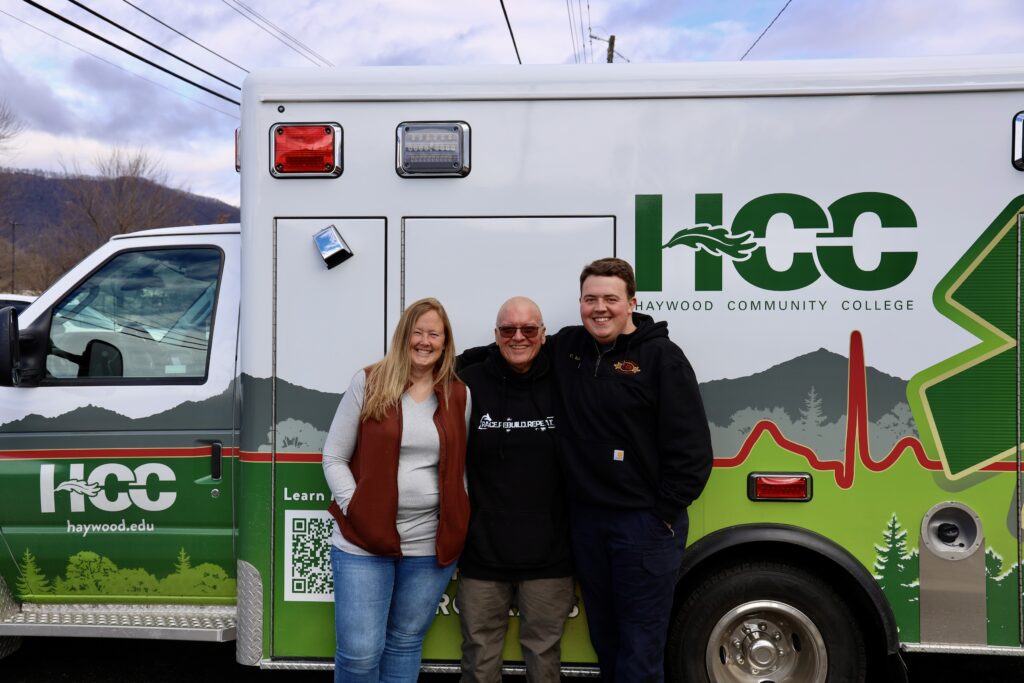
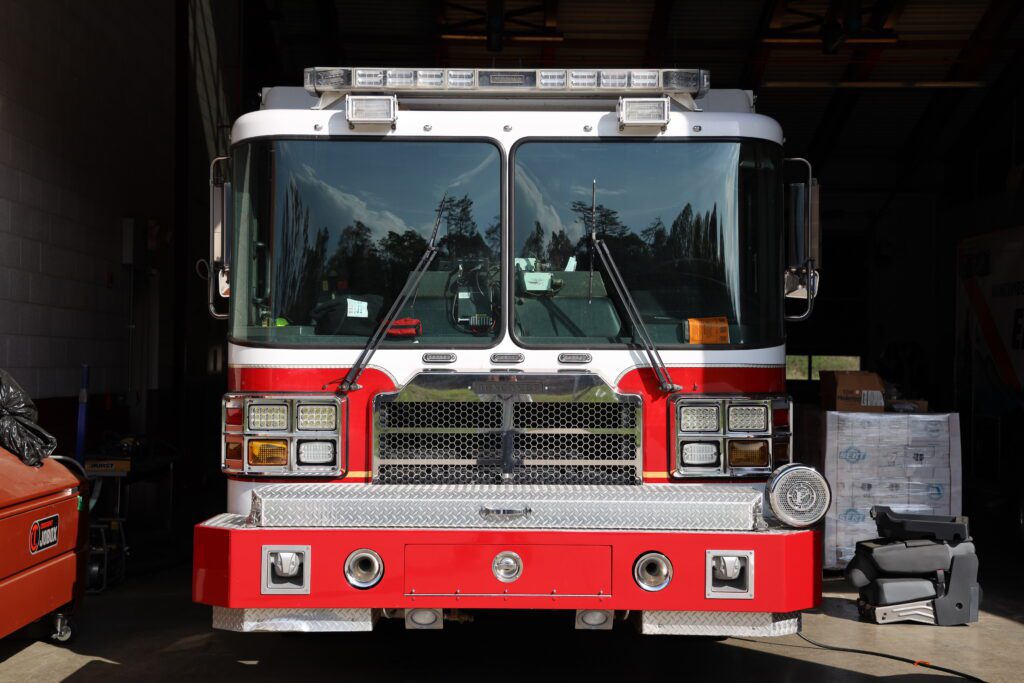
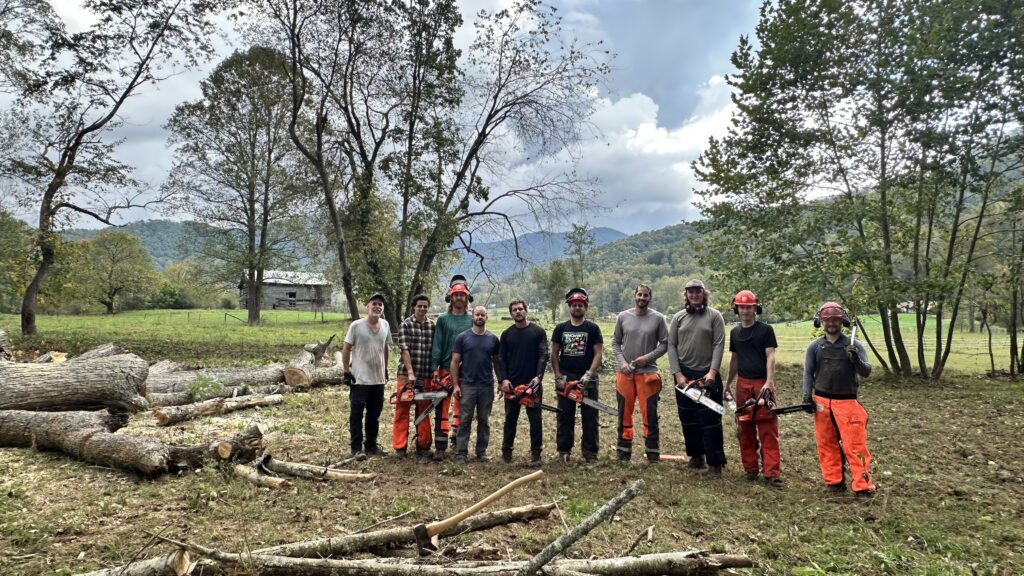
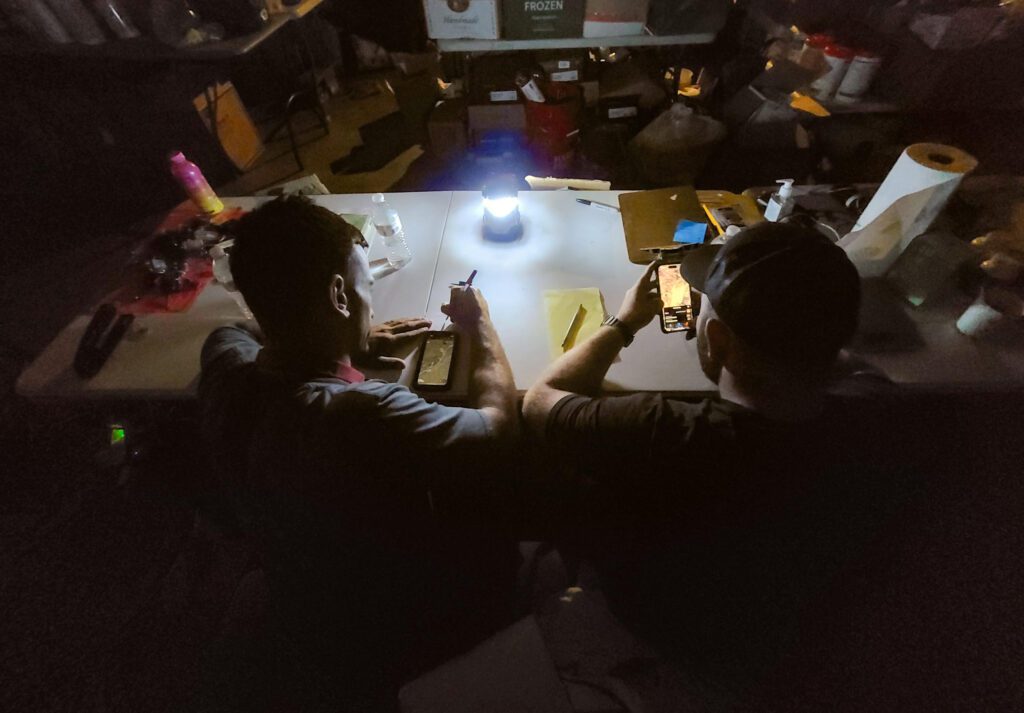
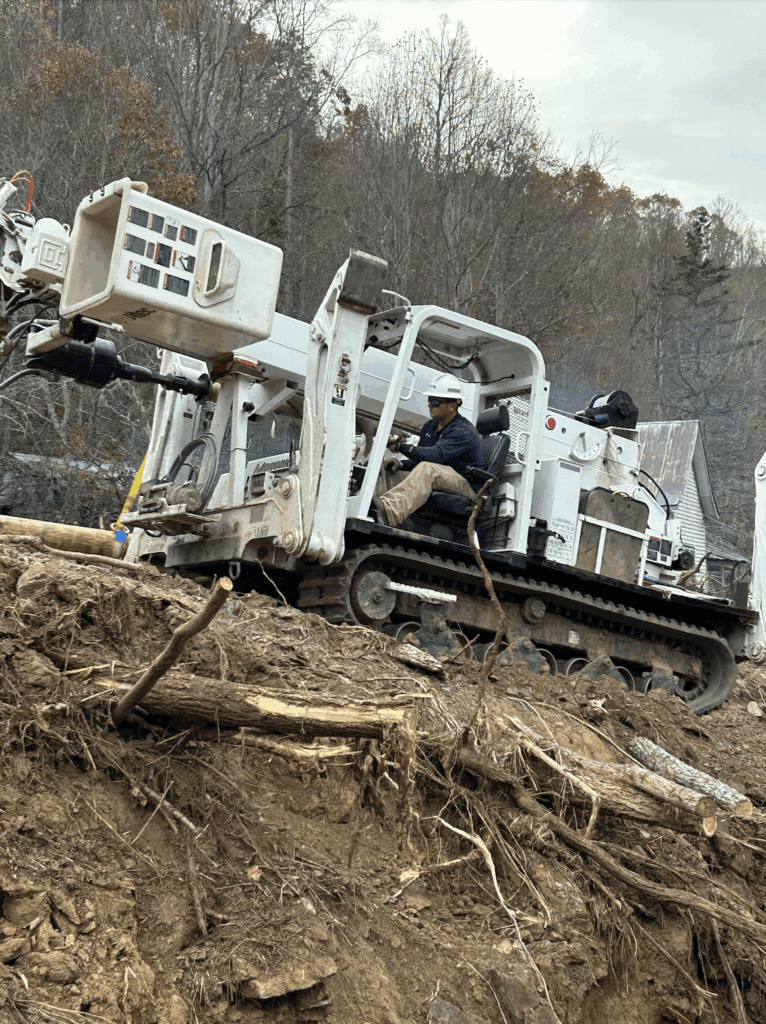
Recommended reading
